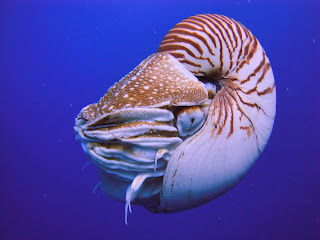Marine Creature of the Month MARCH '19
Marine Creature of the Month
Nautilus
 |
| Photo from Wikipedia |
Kingdom: Animalia
Class: Cephalopoda
Conservation Status: Vulnverable (VU)
WHAT ARE THEY?
Other than a great crochet project? They are a type of cephalopod, the same class as octopuses and squids. Unlike octopuses which are known for their intelligence, Nautiluses have particularly poor memories. There are six species of nautilus and they have been around since the Triassic period, as in when there were dinosaurs about. Because of this, they are regarded as living fossils.
These creatures are shelled and have chambers within their shells. When born, they have four chambers but can end up with as many as thirty as an adult. These chambers contain a mixture of gas and sea water, and the nautilus uses these to control their bouyancy. When they want to be less bouyant, they create a chemical mixture in their chambers which pulls more water in, via osmosis. Ultimately this makes them denser than before so they sink. To rise to the surface they reverse the process, so that the water will flow out and and be replaced by gases - natually making them lighter.
WHERE DO THEY LIVE?
Nautilus are palegic creatures, meaning they are found in deep waters, specifically in the Indo-Pacific ocean. Their habitats are are the deep slopes of coral reefs and they can be found as deep as 700m (2296ft). However, they cannot go much deeper for their shell will implode under the pressure of the water and kill the creature inside. They do not always inhabit the deep waters, they have been known to come to surface for food and mating seasons.
 |
| Photo from California Academy of Sciences |
WHAT SIZE DO THEY GROW TO?
Nautilus are not the biggest creatures, but there is some variety in size between the six species. The largest ever found nautilus was 25.4cm (10in) while the smallest was 11.56cm (4.55in). On average, they are around the 20cm (8in) mark. So, on average it is about the size of a kettle.
WHAT DO THEY EAT?
Nautilus are opportunistic eaters. They will scavenge anything they can get their nine teeth on. Lobster moults, hermit crabs, carrion... Anything they don't have to hunt. They mostly feed at night. Everybody loves a midnight snack!
 |
| Photo from American Museum of Natural History |
WHAT IS THEIR LIFE CYCLE?
Nautilus start life as an egg attached to a hard surface by their mothers, developing in warm waters for about 8-12 months. They are around 30mm (1.2in) when the juveniles hatch. Nautilus are relatively long lived, living to twenty years or even longer. However, they do not reach maturity until around fifteen years, giving them a very short reproductive span. This is also limited by the fact that females only reproduce once a year and have to regenerate their gonads every time. (Ouch!)
WHAT THREATENS THEM?
Once again, the answer to this is people. We over fish them. We sell their shells as tourist souvenirs. And their slow reproduction rates means they cannot replace what we so selfishly take. At the moment, they are listed as vulnerable but this will get worse if the situation is not monitored and resolved. Thankfully, they have been put on the protected species list.
 |
| Model of a nautilus cross-section. From ThoughtCo |
FUN FACTS:
- They lay the largest eggs of any cephalopod, an inch in comparison to the giant octopus's grain of rice sized egg.
- They rely on jet propulsion to move through the water.
- They have up to 90 arms.
- And these arms are coated in a sticky substance which helps them to grab things.
Pinterest Board: #MCotM March '19
Listening to: Girl Power - Happy International Women's Day!



Comments
Post a Comment